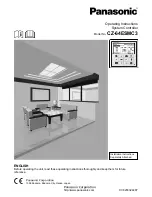
ZENN
iO
AVANCE Y TECNOLOGÍA
vwww.zennio.com
18
3.2.2. SHUTTER CHANNEL
ACTinBOX MAX6 also allows configuring its outputs as shutter channels, being able to
control
up to 3 different shutters
in an installation.
When a channel is configured in ETS as a shutter channel, it appears in the topology window a 1 bit
communication object (“[CX] Block”) associated to each enabled channel, that allows blocking the
channel outputs (disabling the control over them, both the ON/OFF and the timed control) when a
“1” is sent through the object. Moreover, if the shutter is in motion at the moment it is blocked, its
movement will be stopped and any control over it will be cancelled. The channel outputs will be
unblocked when a “0” is sent through the blocking object.
Note:
Only the Alarm function has higher priority than the block function; i.e., if during the block an
alarm signal arrives, the corresponding shutter will be placed as indicated by the alarm. When the
alarm is deactivated, the output returns to the block status.
The first parameter to configure is the type of shutter:
Shutter (No slats):
these are the typical revolving shutters, with a simple raise/lower
movement. When selecting this kind of shutter, 2 communication objects will be enabled:
“[CX] Move” and “[CX] Stop” to raise/lower and stop the shutter movement, respectively.
Moreover, the following Note appears: "Slats positions will be ignored for Shutter types". This
note means that all the parameters that will appear in the enabled functions referred to the
position (%) of the slats cannot be taken into account for this kind of shutters.
Blind (with slats):
special shutters with a secondary movements managed by the same
drive. ACTinBOX MAX6 allows controlling both movements, slats rotation (getting more or
less incident light from the outside) and the raise/lower movement. When selecting this kind of
shutter, 2 communication objects will be enabled: "[CX] Move" (to send the orders of
raising/lowering the blind) and "[CX] Stop/Step". This way, if the device receives a “0” or a “1”
via this last object when the blind is in motion, it shall stop; while if the blind is stopped,
receiving a “0” through this communication object will make slats to pull up, and a “1” will
make slats to pull down. This step up/down functionality is useful to slightly correct both the
slats and the blind position.
To obtain more detailed information about the blinds with slats and its ETS configuration,
please read the
Annex I. Slats precise control.
















































